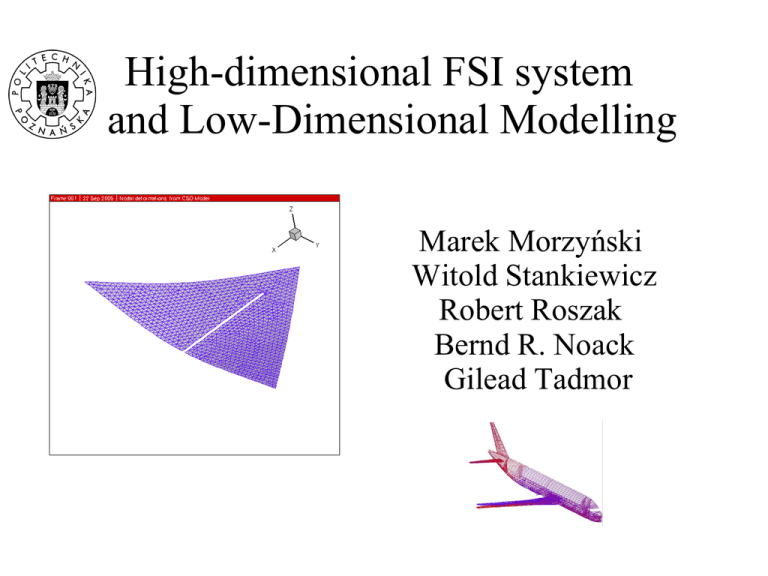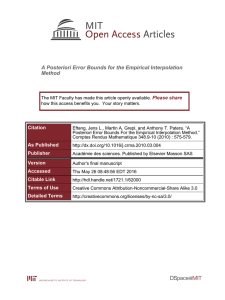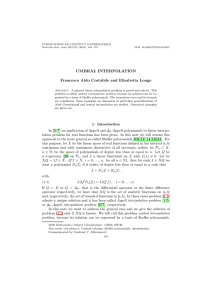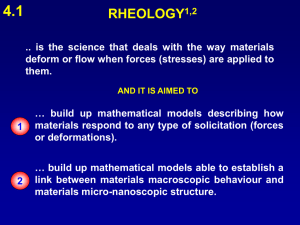Slides (ppt 12.3 Mb) - IFFC-2
advertisement

High-dimensional FSI system
and Low-Dimensional Modelling
Marek Morzyński
Witold Stankiewicz
Robert Roszak
Bernd R. Noack
Gilead Tadmor
Overview
Elements and of High- Dimensional
Aeroelastic System
Loosely coupled aeroelastic system
Computational aspects
Elements of the system
Solutions
ROM with moving boundaries and ALE
ROM in design and flow control
ROM for AE – sketch of challenges and
ideas
ROM AE model - motivation
Need of ROM in design
AIAA 2008, Rossow, Kroll
Aero Data Production A380
wing
Need of online capable ROMs in
feedback flow control
50 flight points
100 mass cases
10 a/c configurations
5 maneuvers
20 gusts (gradient lengths)
4 control laws
~20,000,000 simulations
Engineering experience
for current configurations
and technologies
~100,000 simulations
Aeroservoelasticity
Aeroelastic control
(Piezo-control of flutter, wing
morphing, smart structures)
MicroAerialVehicles
(maneuverability)
High- Dimensional Aeroelastic
System – ROM testbed
t=t+t
Tau
Code
Flow code
Fluid
forces
In-house and
AE tools
convergence
no
Deformed
CFD mesh,
velocities
Interpolation
Forces
MF3 (in-house),
Calculix,
Nastran
yes
CFD mesh
deformation
Interpolation
Structural code
Structure
displacements
and velocities
Spring
analogy
Computational aspects – Euler code
Mesh:
10 mio elements
t=t+t
t=80s
CPU Power:
16 cores
Flow code
Fluid
forces
t=10s
convergence
no
Deformed
CFD mesh,
velocities
Interpolation
Forces
t=4s / 50s
yes
CFD mesh
deformation
t=30s
Interpolation
t=10s
Structural code
Structure
displacements
and velocities
One iteration time: 134s (full CSM) / 180s (modal CSM)
Computational aspects - RANS
Mesh:
30 mio elements
(1 mio: surfaces)
t=t+t
t=400s
CPU Power:
32 cores
Flow code
Fluid
forces
t=90s
convergence
no
Deformed
CFD mesh,
velocities
Interpolation
Forces
t=4s / 50s
yes
CFD mesh
deformation
t=220s
Interpolation
t=90s
Structural code
Structure
displacements
and velocities
One iteration time: 850s (full CSM) / 804s (modal CSM)
High-fidelity CFD and CSM
solvers
CFD - TAU CODE
• Finite volume method solving the Euler
and Navier-Stokes equations
• hybrid grids (tetrahedrons, hexahedrons,
prisms and pyramids)
• Central or upwind-discretisation of
inviscid fluxes
• Runge-Kutta time integration
• accelerated by multi-grid on
agglomerated dual-grids
• miscellaneous turbulence models
• Parallelized with MPI
• Parallel Chimera grids
From DLR TAU-code manual
CSM MF3: in-house CSM Tool
• Finite Element-based
• Rods, beams, triangles (1st / 2nd order),
membranes, shells, tetrahedrons (1st /
2nd order), masses and rigid elements
• Static analysis
• Transient (Newmark scheme)
• Modal analysis
• MpCCI and EADS AE interfaces
ALE - Motion of boundary and mesh
canonical domain
u u u p
1
Re
Eulerian approach
u = 0
M x C x K x F ( x, x , x , t )
Lagrangian approach
Arbitrary Lagrangian-Eulerian (ALE) binds the velocity of the flow u and
the velocity of the (deforming) mesh ugrid.
For incompressible Navier-Stokes equations the mesh velocity modifies the
convective term:
With boundary conditions:
The fluid mesh can move independently of the fluid particles.
Coupling requirements
Alenia SMJ
CFD N-S hybrid grid with 1.3 mio
nodes and 4.7 mio elements (cells)
Alenia SMJ
FEM model with
2,815 nodes
Aerodynamic mesh
12437 nodes
Structural mesh
212 nodes
Z
X
Y
Pressure
forces
interpolation
Coupling tools
The meshes are non-conforming
• different discretization
• different shape (whole wing/
torsion box only
Non-conservative interpolation
Conservative interpolation
Coupling tools
• MpCCi (Mesh-based parallel Code Coupling
Interface), developed at the Fraunhofer Institute
SCAI
• AE Modules, developed in the framework of
TAURUS
• In-house tools, based on bucket search algorithm
AE Modules by EADS and in-house modules perform better in the cases,
when only torsion box of the wing was modelled on the structural side.
Dynamic Coupling: time integration
General aeroelastic
equations of motion :
[M] x’’ (t) + [D] x’ (t) + [K] x (t) = f (x, x’, x’’, t)
Inertial
forces
Newmark direct integration method
xi+1 = xi + t xi‘ + t2 [ ( 1/2 - ) xi‘‘ + xi+1‘‘ ]
Damping
forces
Elastic
forces
Aerodynamic
forces
Structural forces
Integration in time in CFD (or CSM) code
xi+1‘ = xi ‘ + t [ ( 1 - ) xi‘‘ + xi+1‘‘ ]
xi+1 = xi + t xi‘ + t2/2 xi‘‘
xi+1‘‘ = ( [M] + t/2 [D] ) -1 { f i+1 - [K] x i+1 - [D] ( xi‘ + t/2 xi‘‘ ) }
xi+1‘ = xi‘ + t/2 ( xi‘‘ + xi+1‘‘ )
NEWMARK
explicit scheme
with
= 0 and
= 0.5
Fluid mesh deformation
• Spring analogy
• All edges of tetrahedra are replaced with springs (torsional,
semi-torsional, ortho-semi-torsional, ball-vertex, etc.)
• The stiffness km of each spring may be constant, or related
to element size or distance from boundary
• Shephard interpolation
(Inverse Distance Weighting) Based on the distances
di between a given mesh node and boundary nodes:
• Another possibilities:
Elastic material analogy, Volume Splines (Radial Basis
Functions),Transfinite Interpolation
I22 and I23 airplanes
from: wikimedia
Flutter analysis for I-23 airplane
Mach number:
Atmospheric pressure:
Reynolds number:
Angle of attack:
Time step:
Singular input function:
M = 0.166, 0.2, 0.3, 044
P = 0.1 MPa
Re = 2e+6
α = 0.026
dt = 0.01 s
Fz = 2000 N in time t = 0.01 s
Flutter analysis for I-23 airplane
Simulation:
flutter at Ma=0.44
Experiment:
flutter at Ma=0.41
Time history for displacement and rotation
in control node on wing
Flutter Laboratory
IoA and PUT
experiment and computations
•
Scale :
•
Length - 1:4
•
Strouhal number 1:1
Experimental
configurations
•
5 cases – mass added
- 50 grams on the wing's tip
- 20 grams in the middle of
ailerons
- 30 grams on vertical
stabilizer + 20 grams on tail
plane aileron
- 20 grams on horizontal
stabilizer
- configuration
FSI test case 1
#1 - 50 grams on the wing's tip
Results of
test case 1
#1 - 50 grams on the wing's tip
Low-Dimensional FSI algorithm
t=t+t
Flow ROM
Pressure
yes
convergence
no
Deformed
CFD mesh,
velocities
Interpolation
Forces on
structure
CFD mesh
deformation
Interpolation
Structural code
Structure
displacements
and velocities
Amplitudes of
„mesh”
modes
Reduced Order Model of the flow
u u
u p
1
Re
u = 0
1. GALERKIN APROXIMATION
N
u
[N ]
u0
a
i
ui
i 1
2. GALERKIN PROJECTION
u
,u
i
[N ]
0
3. GALERKIN SYSTEM
a i
1
Re
N
l
j0
N
ij
aj
N
q
j0 k 0
ijk
a jak
Navier-Stokes
Equations
Projection of convective term
u ( u u grid ) u p
1
Re
u = 0
Arbitrary LagrangianEulerian Approach
NG
u grid
1. DECOMPOSITION
i 1
ai ui
G
G
2. GALERKIN PROJECTION
u i , ( u u grid ) u u i , u
N
NG
N
q ijk a j a k
j0 k 0
G
G
uk
G
q ijk a j a k
j 1 k 0
q ijk u i , u j
G
N
u u i , u grid
u
ROM for a moving boundary
NACA-0012 AIRFOIL
2-D, viscous,
incompressible flow
= 15˚, Re = 100
(related to chord
length)
displacement of the
boundary and
mesh velocity:
where: T = 5s and
Y1 = 1/4 of chord
length
DNS with ALE
Inverse Distance
Weighted
First 8 POD modes:
99.96% of TKE
ROM for a moving boundary
Eulerian ROM vs ref. DNS
Dumping of oscillation
typical for sub-critical Re
ALE ROM vs DNS
The first two modes
AE mode basis
for a flow induced by structure deformations
• Test-case: bending and pitching LANN wing
• Fluid answer to separated, modal deformations
(varying amplitudes)
• Fluid answer to combined deformation
Pressure field and
structure deformation
(high-dimensional
AE)
LANN wing structure
ROM AE: CFD → CSM Coupling
• We preserve full-dimensional CSM and existing AE coupling tools to
interpolate fluid forces on coupling - “wet” - surface;
(similarly to Demasi 2008 AIAA)
Neighbour search:
ae_modules f_cfd2csd
Pressure interpolation:
ae_modules b_cfd2csd
where si (i=1..15) is a
distance from CFD
node to closest CSM
elements
• High-dimensional fluid forces retrived from the Galerkin
Approximation
ROM AE: CSM → CFD
Coupling and CFD mesh deformation
• Linear CSM: deformation decomposed onto mesh modes; Galerkin Projection
of ALE term is performed during the construction of GM
• Solution of resulting Galerkin System requires only the input of mesh mode
amplitudes
NG
u grid
i 1
ai ui
G
G
q ijk u i , u j
G
G
uk
• Time stepping: the mesh deformation/velocity calculated for next time step with
the Newmark scheme
ui+1 = ui + t ui‘ + t2 [ ( 1/2 - ) ui‘‘ + ui+1‘‘ ]
ui+1‘ = ui ‘ + t [ ( 1 - ) ui‘‘ + ui+1‘‘ ]
Mode interpolation
Parametrized Mode Basis (Reynolds number here)
OPERATING CONDITIONS II
POD
modes
time-avg. solution
=0.25
=0.50
shift-mode
=0.75
Eigenmodes
steady solution
M. Morzynski & al.. Notes on Numerical Fluid Mechanics 2007
OPERATING CONDITIONS I
Tadmor & al. CISM Book 2011
-fast transients
Results and Conclusions
Advanced platform for FSI ROMs testing open for common
research
Computations ongoing
Treatment of CSM - evolution
Linear CSM model
Non-linear CSM model
Tadmor & al. CISM Book 2011 – control capable AE model
Mode parametrization
CFD/CSM
Coupling
Canonical computational domain
Coupling in Low-Dimensional
AE
• Full-dimensional CSM
• The algorithm essentially the same as the high-dimensional one
• Interpolation of pressures/forces required
• Interpolation of boundary displacements and mesh deformation
required: dependent on the chosen approach of boundary motion
modelling (acceleration forces / actuation modes / Lagrangian-Eulerian
/ …) – Tadmor et al., CISM book
• Modal CSM
• The aerodynamic forces on the surface of structure might be related
to the POD (or any other) decomposition of pressure field
• Thus: interpolation of pressures/forces not required
• Mesh deformation (velocity) modes / actuation modes calculated in
relation to the eigenmodes of the structure
• The amplitudes of „mesh” modes calculated from the amplitudes of
eigenmodes of structure (time integration?)
• Thus: interpolation of boundary displacements and mesh deformation
not required


